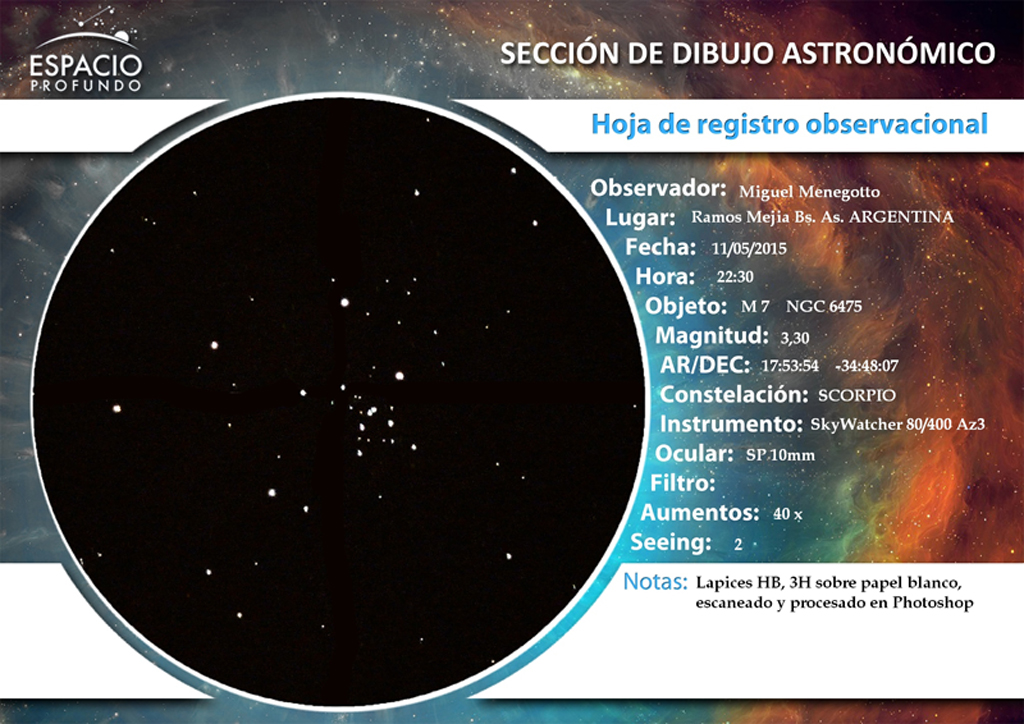
Object Name M7
Object Type Cumulo Abierto
Location Ramos Mejia – Buenos Aires – Argentina
Date 10/05/2015
Media (graphite pencil, white paper, digital tools: Phootoshop CS6
Miguel.

Object Name: M44 (Praesepe/El Pesebre)
Object Type: Open Cluster
Location: Leioa (Bizkaia) – Spain
Date: 2015-04-01 / 23h 35m U.T.
Media: White paper, HB graphite pencil, scanned and inverted/processed with Photoshop
Telescope: Meade ETX 70AT
Eyepiece: Hyperion zoom 8-24mm a 8mm (44X)
Transparency: City Skies.
Location Constellation: Cancer
Assessments:I use the zoom eyepiece at 8mm position (44X), center brighter area of cluster and start to draw what I see, initially see little stars, and as I start acclimating sight see more stars and more clearly, some brightest stars and other stars least, I drawing that I saw, the Moon is almost full and does not help in the observation and I greatly clear sky.
Comentarios: Utilizo el ocular zoom en la posición de 8mm (44X), centro la parte mas brillante y comienzo a dibujar lo que veo, al principio veo pocas estrellas, pero a medida que voy aclimatando la vista comienzo a ver mas estrellas y mas claramente, unas mas brillantes y otras menos, dibujo las que voy viendo, el que la Luna este casi llena no ayuda en la observación ya que me aclara mucho el cielo.
For more details of my observation, you can visit my blog:
https://acercandoelcosmos.wordpress.com/2015/04/09/m44-el-pesebre-cumulo-abierto-en-cancer/
Thank you and best regards
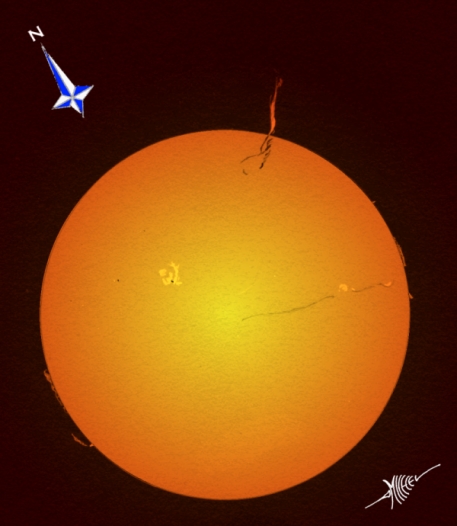
On April 28th, I had the opportunity to follow the evolution of this very nice and long prominence.
That was made using a very small Lunt in Halpha (35mm) the total sketch time was less than 2h.
The full view sketch was made using black pencils HB and 4B on white paper and with the help of transparent paper for the active zones, inverted while scanning.
For the sun’s “comic” I sketch only on white paper with a HB pencil, I had no time to sketch more details and the other details were quite calm facing the prom evolution.
This kind of exercise is interesting because no space probe, nor camera are programmed or able to send us such a big number of photo’s and so quick. Let’s say this is another evidence why sketch is still an interesting technique, as is ASOD !.
The filament, origin of this prom is visible on the main sketch and on the first one of the sequence, after that the filament disappear. At the end I just add a digital color layer to my sketch with the use of Paint.net.
Thank you to you all for your interest and on top of that thank you to the ASOD team for their work.
Michel Deconinck
http://astro.aquarellia.com
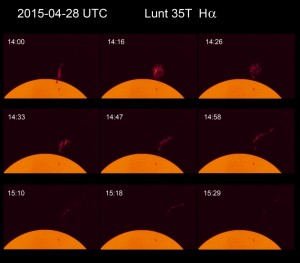

Object: Melotte 111 (open cluster, Coma Berenices)
Date: 07. 05. 2015.
UT.: 19h36m-22h27m
Equipment: 72/432 Lacerta ED refractor, 2” Lacerta star diagonal, Tele Vue 55 mm Plossl eyepiece
Mag.: 8x
FOV: 6,4°
S = 4 / 10 T = 4 / 5
Observer: János Gábor Kernya
Location: Sükösd, Hungary
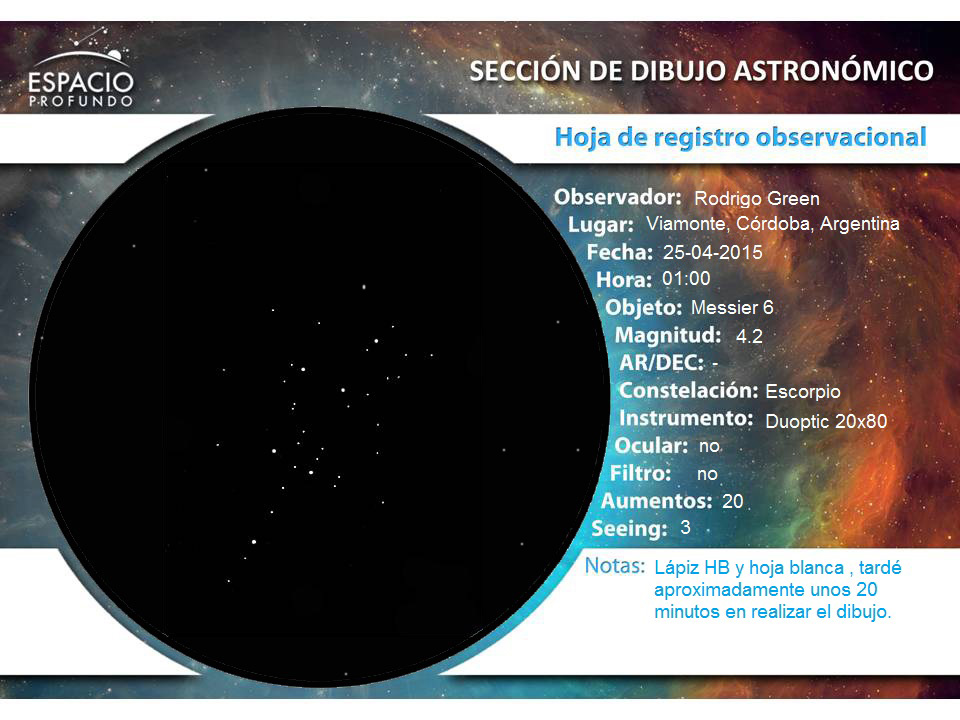
Hello ASOD, this time I send this drawing of Messier 6
Author: Sergio Rodrigo Green
Object: Messier 6
Constellation: Escorpio
Seeing: Excellent
Tools: Pencil HB, and white sheet.
Location: Viamonte, Argentina.
Date: 24-04-2015
I send you a big hug and wished posteen my sketch, Greetings!
Rodrigo.
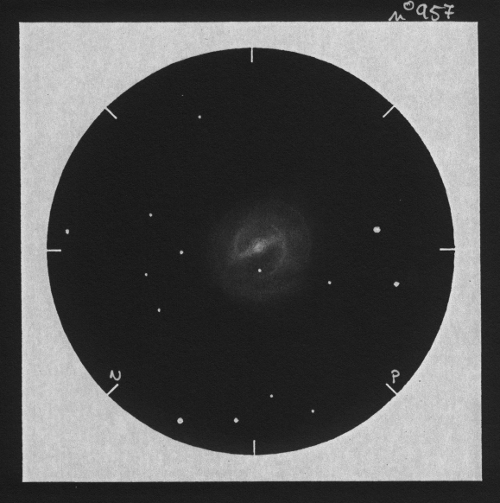
Hi ASOD,
Please find hereby a recent sketch of the barred spiral galaxy M109 in Ursa Major, made during our astro-holiday in Northern France about a month ago. That night the sky completely cleared out with impressive SQM values around 21.6 – being amongst the highest possible in light-polluted Western Europe.
One of the objects scheduled to revisit was Messier 109, since it contains a complex barred spiral structure that is difficult to visually discern. Attentive averted vision under a dark sky though brings out these beautiful features!
Sketch details:
Location: 18 April 2015 – 23h54 UT – Grandpré (Fr)
Conditions: NELM 6.6 – SQM-L 21.6 – Seeing moderate
Optics: SCT C11 (279mm f/10) – Nagler 13mm (215x – FOV 23 arcm) – no filters
Media: graphite pencil on white paper, scanned & inverted using GIMP2
Notes:
Large diffuse face-on galaxy, displays a bright core containing a diagonal barred structure through a round, mottled glow. Attentive averted vision brings out a subtle theta-like structure, less intense at the eastern side and more pronounced on the northwest and southern outer side. The inside of the barred spiral, to the eastside of the core, appears more dark and contains a nice faint field star.
Additional observations of that night can be found in the deepsky database www.deepskylog.org
Clear nights !
Tom

Object Name: Copernicus Crater
Object Type: Lunar Crater
Location: Ottawa, ON, Canada
Date: 2 May 15
Media: Vine charcoal background, graphite pencil for the crater
I am very new at sketching, this being the first one I’d consider worthy of uploading. It was drawn from a photo of Copernicus crater I brought up on my computer screen as practice for the sketching course I’m currently taking. I’m still struggling to convey a sense of depth, as well as develop a rapid technique that I will need when I am at the eyepiece of my telescope.
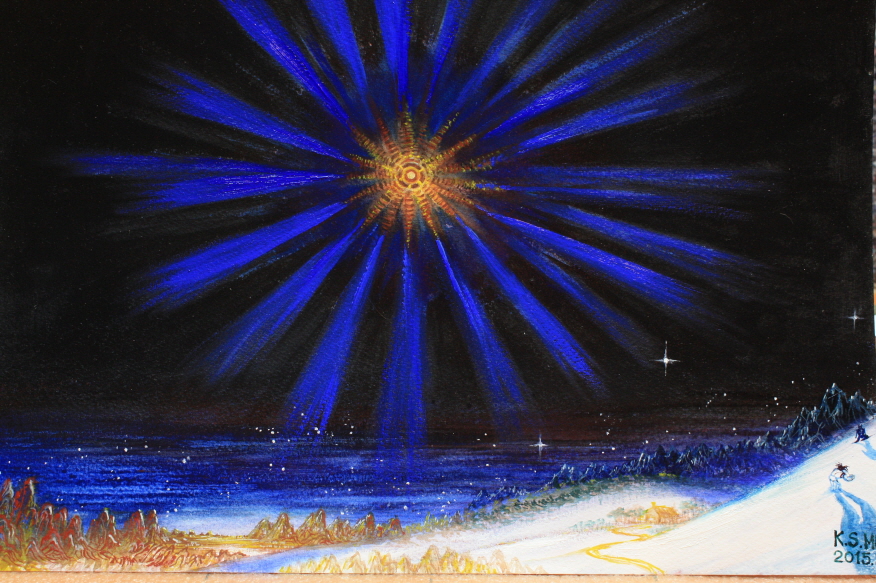
The Zuben-eschamali…. a old beautifuly Arabian-named emerald greenish blue star was lonely shineing that May night just a year ago when l firstly aimed fixed star with freshly constructed 13″ refractor at the highest power which can bears. For more than 2 decade l usealy like to see the fixed single stars of 3-0 mignitude range especially since from the time my 8″, 8.5″ glasses were used
and l looked Vega, Arcturus, Sirius, Capella, Alteir, or 2-3 mignitude stars like this one through 12,13″ glasses particularly at high power 950-1500x . l represented the Zubeneschmali as possible as l can do as you see here but the real thing was far from my humble art for in the 1480 magnification Nagler 2.5s window image l can explain nothing but it was eradiating beautifuly & magnificently, even l felt eerie emotions with the large but still sharpest star image ragely gushed out spokes of light bunches. To explain the 2.6 mag, 160 ly distant alien sun, l made some 20 pages eyepiece sketches with explanationes & l introduce here only one on the recent night Arcturus record as almost 2-0 mag suns to be looked similaly except colors , l named myself the 3 parts at the 1000-1480x images ( under 1000x the 3 parts could not be seen easily with its break downed parts ) as a Diffraction disk part(Airy disk) , 1st flames part , Spokes part …. one 1st flame exactly confrontations one spoke each other & total number of this star,s spokes was observed of 18-25 bunches at every 1/30 second because ca 3-4 rowes of radial spokes rotating each other in slight different directions that l could not represent it here for the spokes were so dynamic as each 3-4 rows spokes rotated once in a 1/50-1/30 seconds that may lie in a human eye,s limited captureing time spans so there l could observe the perspective among the 3-4 rows….
For the other explanations l have to omit as thousends words not equals to just you look through once.
With these observations of years l could more &more feel the fixed stars are alien suns like ours in not fictions (in papers or photos) but in reality, reality emotion… that l feel only just a few minutes for in a full one year,s automatic robotic diary life time span , stangely , in my private opinion , we humanbeing (include other species on earth?) have not yet the 7th sensor organ feel direct the existent emotions in cosmos.
l have to thanks for the pioneers who firstly sought the star parallaxes.
My humble instruments are imposing enough against the 5 billion doller HST at least when they aim fixed stars , if l seated in it with 15,000x power, it,ll show me nothing but a 1/10 diameter Airy disk of mine even the HST can,t show the Alien sun,s limb circle even in pinpoint size at all that tells the vastness of the interstellar space.
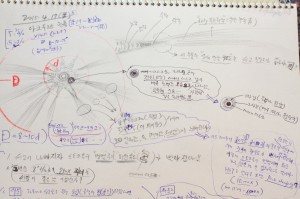
K.S. Min
Observed; 2014. 5
Painted ; 2015. 5
320mm refractor x1480
Graphite pencils, water color, acrylic& oil color, white paper 30x45cm (working time; 4 hours)
Himax follows the Blackmax climing snowy hills where on a old Taoism landscaped alien planet in the Zubeneschamalli solar system
Photographed in a room w/ lights with a Canon 450d camera
South Korea